Nov-15-22
 | | KEG: Whenever Marshall and Mieses squared off, a true doneybrook was likely. So it was here. They played 31 times throughout their careers, Marshall winning 13 times against 10 loses and 8 draws. In 1908, they played a match; Marshall prevailing 5 to 4 with only one draw. The instant game was one of their many explosive battles; far from perfect chess, but never dull. 1. e4 e5
2. Nc2
Mieses liked the White side of the Vienna Game, and played this opening frequently, including several times in his 1908 match against Marshall. He had tried this opening in his game against Marshall at Paris 1900. Marshall had won that game, but that didn't deter Mieses here. 2... Bc5
2...Nf6 is of course more usual, but Marshall had played this more aggressive response against Mieses at Paris 1900, and he played it in all five of his games as Black in his 1908 match against Mieses. 3. Bc4
A move championed in the past by Zukertort and Blackburne. Mieses played this move in the above-cited game at Paris 1900, but in the 1908 match he played 3. g3 in four of his five games as White and 3. Nf3 in the other. The aggressive text suited Mieses' attacking style. 3... d6
At Paris 1900 against Mieses, Marshall played 3...Nc6 and then had to face 4. Qg4, getting (and winning) the wild game he no doubt expected would result. The soundest response is 3...Nf6, but neither of these players was ever keen to avoid a pitched battle. 4. d3
4. Na4 (getting rid of the dark-square Black Bishop seems logical. 4. Qh5 was an aggressive alternative that might have been expected from Mieses. But, as will be seen, he had another attacking concept in mind here. 4... c6
A good move that was a novelty at the time. 4...Nf6 is most usual here, but the text is also fine. 5. f4?!
Mieses apparently couldn't be bothered with the sound 5. Nf3 or with 5. a4, or even with 5. Qh5 (which also has its points). The text left made a mad-cat fight almost inevitable with these two lovers of slash and kill combat on the chess board: 
click for larger view5... BxN
Condemned by Hoffer (whose comments on this game appeared in the Tournament Book). Marshall's move looks reasonable to me, but arguably 5...b5 or 5...Qh4+ or 5...Nf6 may be best. 6. RxB Qh4+
7. Kf1
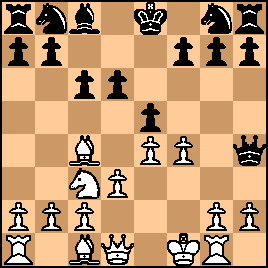
click for larger view7... Nf6
7...Bg4 was surely best and would have given Marshall much the better chances. After the text, things got wild. 8. Rh1
"Best. The pawn must be defended." (Hoffer)
8... exf4
9. Qe1!

click for larger view9... Qh6
"Exchanging Queens would leave White the better game, as the gambit pawn would have to fall." (Hoffer) Black would not have been in any serious difficulties after 9...QxQ+ 10. KxQ Nh5. It is the text that gave Mieses the edge. Best, however, was probably 9...Qg5. 10. e5 Ng4
11. exd6+

click for larger viewIn his zeal to attack, Marshall beginning here got into trouble. But as so often in Marshall-Mieses games, the wild complications soon thereafter swung the game in Marshall's direction before further wild play allowed Mieses to build a winning advantage. From the above-diagrammed position, however, it would have been hard to guess how the game would go. Most of us would play 11...Ne3+ here. But, as will be seen, Marshall had quite different attacking ideas in mind. |
|
Nov-15-22
 | | KEG: Post II
11... Be6?!
Why did Marshall play this rather than 11...Ne3+? His next move told the tale. 12. Qe4!
Very strong, combining attack and defense. But he likely didn't anticipate Marshall's next move, Rather than 12...0-0 or 12...Ne3+ or 12...Nd7 or 12...Nf6 (all sensible tries), Marshall went for broke with: 12... g5?!
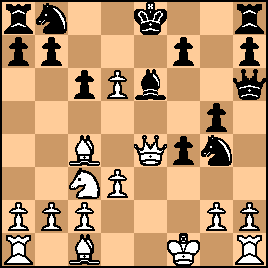
click for larger viewThe sort of move that got Marshall into trouble in 1901 and 1902. Mieses (White) now had what looks like a clear road to victory with 13. BxB QxB [or 13...fxB 14. Qe2 Ne3+ (best but insufficient) 15. BxN fxB 16. Qxe3 Na6 17. Ke2! 0-0-0 18. Ne4 and Black has too many weaknesses] 14. h4! QxQ (Black has nothing better) 15. NxQ f5 16. Nxg5 and Black's position is a mess. After the text, by contrast, Marshall was very much back in the game. 13... Nd7
14. Kg1
Perhaps 14. g3 was better. After the text, Marshall suddenly had dangerous counterplay: 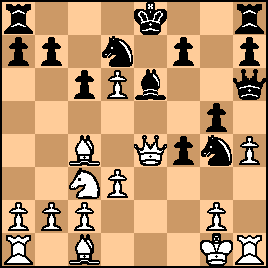
click for larger viewHad Marshall here played the seemingly obvious 14. 0-0-0, anything looked possible. But instead, he strangely played: 14... Ngf6
Now it was Mieses who had chances:
15. Qe4
This permits 16. Qf2 which gives White excellent chances. But... 15... Rg8
16. Ne4
Huh? Why not 16. Qf2. Now Marshall had an easy route to solving most of his problems: 16... NxN
17. QxN Nf6

click for larger viewIn this extremely complicated position, it was anyone's game. 18. Qd4 BxB
19. dxB
Inferior was 19. QxB 0-0-0
19... 0-0-0

click for larger view20. Bd2
As Hoffer pointed out, 20. Qxa7? would be a disaster for White after 20...Rxd6 since White now had to contend with a possible 21. Rd1+ by Black [e.g., 21 Qa8+ Kd7 22. Qxb7+Ke6 and now 23. Bd2 hangs a piece while 23. Kf2 gets clobbered by 23...Ne4+]. The text, of course, is much better, but better still for White would have been 20. hxg5 [20...Qxg5 21. Rh2 with an unclear position with all sorts of chances for both sides]. 20... Nh5
20...gxh4 was perhaps even better.
21. Qa7
This sortie by the White Queen was now playable. 21... Qxd6
22. Qa8+ Qb8

click for larger viewAlready quite a game. But from here both players lost their way (perhaps time pressure given the move-30 time control) and in the next few moves both players reached winning positions until in the mad complications Mieses emerged on top. In the diagrammed position, Mieses could have likely reached a drawn (but still tricky) endgame with 23. QxQ+ KxQ 24. hxg5 RxB 25. RxN Rxc2 26. b3. But Mieses wanted more, and nearly got hammered (until a couple of Marshall overreaches gave him a win). |
|
Nov-16-22
 | | KEG: Post III
23. Qa5?
Typically (and not necessarily because of time trouble), Mieses chose to keep the Queens on the board rather than enter what would probably have proven to be an even ending. This was wrong in theory, since White is likely lost with best play, but right in practice, since Marshall overreached and converted what should have been a win into a loss. 23... Ng3
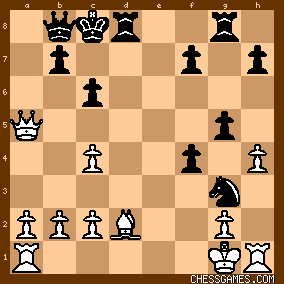
click for larger viewThings were looking good for Marshall at this point, and his stock rose when Mieses again lost his way with: 24. hxg5?
24. Be1 was Mieses' best theoretical chance here (24...NxR [or 24...g4 25. BxN fxB 26. Qf5+ Rd7 27. Rd1 with at least practical chances of survival] 25. KxN Rge8 26. Qf5+ Rd7 27. Qxg5 again with some hope of hanging on). The text, by contrast, should have been fatal. 24... f3
Hoffer's suggested 24...b6 was probably stronger, but the text--though more complicated--probably also wins The position was now:
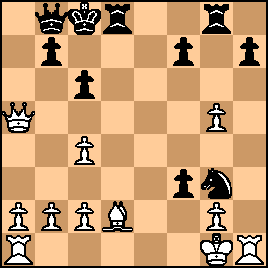
click for larger view25. gxf3
Probably White's best chance. If instead 25. Rxh7? Black wins easily after 25...RxB 26. gxf3 [26. QxR loses to 26...Ne2+ 27. Kf1 Qa7] 26...Ne2+ 27. Kf1 Qf4. After the text (25. gxf3), Black still had a likely win: 
click for larger view25... Ne2+?
With good winning chances, Marshall faltered here. Hoffer's contrary analysis notwithstanding, Black would likely have been in good shape after 25. NxR 26. Qf5+ [the move Hoffer mistakenly claimed would lead to lines similar to what actually occurred in the game) Rd7 27. Bf4 Ng3 28. QxR+ KxQ 29. BxQ RxB with a won ending, Black having a Knight for two pawns. After the text, White was obviously better. 26. Kf1
Forced.
26... Ng3+
Better than 26...RxB 27. QxR Ng3+ 28. Kg2 NxR 29. f4! h6 30. RxN hxg5 31. Kf3 gxf4 32. Qxf4 QxQ+ 33. KxQ with winning chances for White even though his extra pawn is a doubled pawn. 27. Kg2

click for larger view27... NxR?
With his clock ticking and the move-30 time control fast approaching, Marshall blundered away his chances and gave Mieses a winning edge he never relinquished. 27...Rge8 would probably have been sufficient to save the game for Marshall. But now: 28. Qf5+
"Now comes the final attack." (Hoffer)
28... Rd7
29. Bf4
An even simpler winning line than 29. RxN
29... Qa7
29...Ng3 was better, though probably not good enough to save the day. 30. RxN
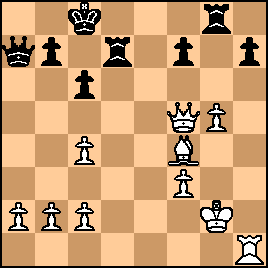
click for larger viewThis was almost certainly a win for Mieses, but there would be some ups and downs before the game finished even though Mieses never lost his winning advantage (though he would come close to doing so) Material was nominally equal, but White's Rook stands well and the White King-side pawns (despite the doubled c-pawns) were too much for Marshall to handle in conjunction with White's other threats. |
|
Nov-17-22
 | | KEG: Post IV
30... Qd4
This final move before the time control only made things worse for Marshall. Of course, 30...Qxa2?? would have been a catastrophe for Black after 31. Rd1 Rgd8 32. Qe5! Black's best chance--though not much of one--was 30. Kd8. After the text, Mieses should have made short work of Marshall, but his play--even with the time control reached--now became sloppy: 31. c3 Qb6
If instead 31...Qg7 32. Qa5 is murder. And if 31...Qxc4 32. Qe5 forces Black to part with at least a Rook to stave off mate. So the text was relatively best, but no great bargain for Marshall: 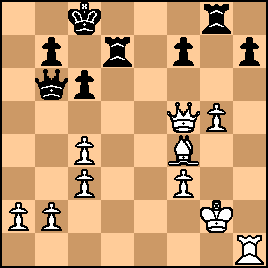
click for larger viewEven now, 32. Qe5 would leave little play for Black. But Mieses missed this and instead played: 32. Rd1?
This didn't blow the win, but now Marshall had a chance to regroup: 32... Qd8

click for larger viewMieses would still be close to victory with the simple 33. RxR QxR 34. Qa5 Qd8 35. Qa8+ Kd7 36. Qxb7+ Ke8 37. Qxc6+ Qd7 38. Qa8+ Qd8 39. QxQ+ KxQ with a winning endgame with his four passed pawns on the Queenside for the exchange. But here Mieses nearly did forfeit his won game: 33. b4?
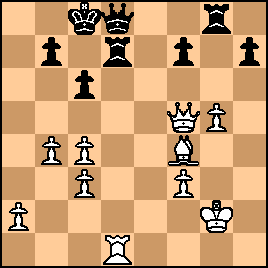
click for larger viewNow Marshall could have kept the White Queen off a5 by playing 33...b6. Perhaps even stronger was 33...Rg6. But Marshall missed any chance of holding the game with: 33... Re8?
Now, Mieses was off to the races:
34. RxR QxR
35. Qa5

click for larger viewMarshall now could perhaps still have offered some resistance with 35...Qe7 or maybe 35...Qd8, but instead he neutered any chance of serious counterplay with: 35... Re2+?
36. Kg3
Obviously forced to avoid mate in one, but now Marshall had no meaningful attack while Mieses was threatening mate on the move. What followed now was a massacre: 36... Qe7
37. Qa8+ Kd7
38. Qxb7+

click for larger view38... Ke6
Perhaps the worst move available to him, but by now it hardly mattered. 39. Qxc6+ Kf5
40. Qd5+ Kg6

click for larger viewMarshall chose to play on, but the finale could not have been any fun for him and Mieses had no trouble wrapping up proceedings as I will show in my next post on this game. |
|
Nov-17-22
 | | KEG: Post V
41. Qd6+
41. c5 is more brutal and faster, but with the move-45 time control not far off, Mieses can't be blamed for seeking simplicity. 41... QxQ
42. BxQ

click for larger view"The Bishop and the passed pawns are now decisive. It only requires ordinary care." (Hoffer) 42... Rxa2
Hopeless, but so is everything else.
43. c5
43. b5 was faster. The text prlonged Marshall's agony. 43... Kf5
43...Kxg5 was no better, e.g., 44. b5 h5 (as good of bad as anything) 45. c6 h4+ 46. Kh3 Rf2 47. f4+ Kh5 48. c7 Rf3+ 49. Kh2 Rxc3 50. b6. 44. b5

click for larger view44... Ke6
45. Bf4 Rb2
46. c4
Too many pawns for Marshall to handle.
46... Rb4
47. c6 Rxc4
48. b6!
"The winning move." (Hoffer)
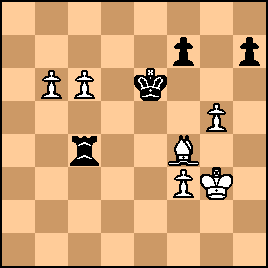
click for larger view48... Rxc6
49. b7 Rb6
50. b8(Q) RxQ
51. BxR

click for larger viewFor whatever reason, Marshall chose to suffer a bit more. 51... Kf5
52. Bf4
Zugswang, not that Mieses needed this resource given his extra Bishop. 52... f6
53. gxf6 Kxf6
54. Kg4
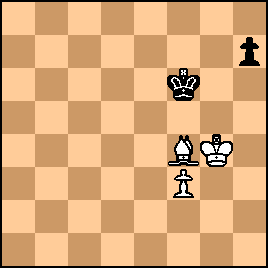
click for larger view1-0 |
|
|
|
|





